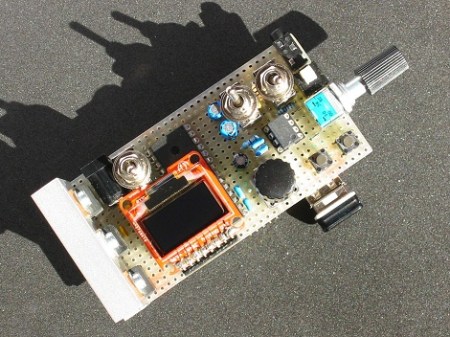
[Markus] on the DangerousPrototypes forum came up with a great little SID player.
The SID was (is?) the awesome sound generation chip inside the Commodore 64, and along with Game Boys and NESs laid the foundation for the chiptune scene. We’re happy to finally see a small SID player that doesn’t resort to SID emulation or a relatively huge MIDIbox.
The SID player itself is a shield on a CUI32 PIC dev board. The PIC32 emulates the 6510 and 6526 CPU and CIA chips found in the Commodore 64. A small USB memory stick stores the High Voltage SID Collection and the file system is navigated with an OLED screen. [Markus] says that the player draws 370 mA, so he runs it off a small wall wart. Still, we’re wondering if it’s possible to run this off of an SD card with a SwinSID so power draw can be reduced and a fully portable SID player can be realized.
We’ve got a touch of nostalgia for chiptune and demoscene music right now, so we’re going to listen to some [Nelly Furtado] [Janne Suni] right now, but you can check out the video demo [Markus] posted after the break.
[youtube=http://www.youtube.com/watch?v=gw-TQaskkQ8&w=470]















i love this player!
check out my favorite site for old tunes:
http://www.kohina.com/
Neat project. I notice it’s another project that lacks bypass capacitors on the linear regulators. Which begs a question for you other EEs out there. Has anyone ever seen a linear regulator or LDO with stability problems because they didn’t have the correct bypass/compensation capacitors or too-large of ground loops?
This site has the sids from the hvsc converted to mp3 from actual c64 (not emulation):
http://www.6581-8580.com/
Somebody needs to do the same with the ensonic chip from the AppleIIGS.
This is so badass. It’s hard to tell from the video, but yes, there is an actual SID chip in there.
I got chills when Last Ninja 2 Central Park came on… he should have let the song play out!
Too bad it’s not battery powered. Current draw and the steady 9V supply requirement for the SID probably make that tricky.
Also, does anyone happen to know who’s got the California license plate “MOS 6581”? Used to see that car parked in my old apartment complex, always wanted to track him down and give him a high five.
Yes, I’ve seen an LM340 regulator oscillate due to lack of a capacitor. It wasn’t your typical case, since it was driving 20 feet of wire, but it managed to completely wipe out TV reception on channel 5 with no other negative consequences. One capacitor between the output and ground solved the problem.
This is pretty badass. I’d really like to see this done with the SNES APU instead of the SID… portable SPC jukebox!
@DanJ, yes LDO’s are typically very sensitive to minimum capacitance requirements, and will oscillate out of regulation when a decent load is placed on them with not enough output capacitance. Also, at very cold temperatures the output chip caps tend to decrease in capacitance, so if you add the bare minimum you might have issues. I always double the minimum value to be on the safe side.
The SID made the long 1541 floppy drive load times worth it.
Great !
“relatively huge MIDIbox.” it’s not that huge, it depends on what you build. A stereo Midibox SID without any controls isn’t big.
But a Midibox octo SID with full controls takes of course some place.
I’m full of envy.
That ROCKS!!!
As a veteran games programmer I really ought to do the same with the old “AY” chip and re-live the 80’s!
You can’t beat retro video game reconstructions.
I’ve started on a rebuild of my Defender arcade machine starting with the SOUND BOARD, grab a look here.
http://www.youtube.com/watch?v=-4NtdjF1EvI
@DanJ, Ya, I’ve seen plenty of prototypes where the layout guy didn’t put the bypass caps in the right place or the ones where we forgot to put a 10uF on the board for local filtering from the wall wart. Every time you draw a buunch of power (turn on a LED) it reboots and you get that “WTF” look on your face.
If your system’s demand isn’t spiky or your chips have tolerance for low voltage, you can get away with it, but at higher clock speeds the probability becomes very high. Random resets are a pain to debug.
In this case, I’m guessing that the power demand is pretty constant so the filtering done at the wall wart is just about enough to make it work.
Hi, I posted a follow-up video demonstrating digi-support. This allows playback of tunes containing sampled sounds. Two things to keep in mind:
* The emulator code (TinySID) can only playback tunes in PSID format (in which the majority of the files in the HVSC are). However, with update #50 the digi-tunes in the HVSC have been replaced by ones in the newer RSID format. The old PSID digi-tunes are still avaliable separately here: http://www.hvsc.de/download/files/archives/C64MUSIC_PlaySID.rar
So use these for your digi pleasure :)
* The SID 8580R5 needs a digi-boost hack to play the digis sufficiently loud. Add a 330 k resistor from EXT IN to GND, preferrably using a switch.
Here’s the URL of the video http://www.youtube.com/watch?v=1nCUBvLy_ps
If you love chip tunes then you should check out http://Chiptunearchive.com it has over 250,000 chiptunes xD !!!
I love chiptunes. If you want to read more, I have a small article here: http://www.ageofaudio.com/en/micromusic/chiptunes-making/
how to do chiptunes with software and tips for beginners too.
I hope someone is producing SID chips and that the masses are not eBaying old C64’s from potential good homes just to rip a chip out and discard them!!
**JUST SAY NO TO SENSELESS C64 KILLING**